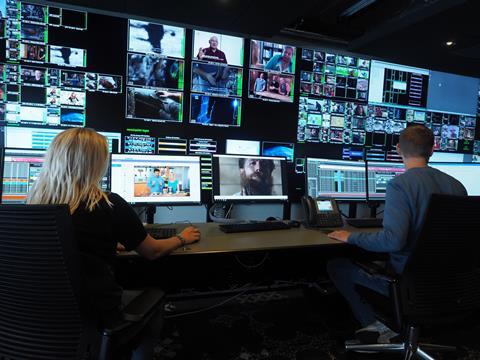IBC Innovation Awards finalist DMC leads the way with cloud based playout services.
DMC, a TVT company, has migrated from broadcast playout centre to comprehensive media logistics service.
It has migrated to a fully virtualised private broadcast cloud that provides DMC’s clients with the asset management, publishing and distribution services they need, linking international content owners with 700 million European viewers.
The new platform was developed with Cisco, Equinix, Pebble Beach Systems, Red Hat, Super Micro and VMware and submitted for the IBC Innovation Awards.
DMC General Manager and Vice President Raymond Lamphen explains.
What was the initial challenge you faced: technical, creative or commercial?
Our initial challenge was the transformation taking place in the TV industry earlier this decade that redefined the media landscape for our clients and for content services providers like ourselves. The growth of on-demand and on-line video, declining and shifting advertising revenues and an increasingly media savvy consumer was putting pressure on our customers - major content owners, media companies and studios - as they faced changing business and revenue models.

At the same time there was a paradigm shift happening in the video technology space and major moves from broadcast hardware to commodity compute; from physical to cloud virtualisation and software-defined, and from baseband to IP.
We realised that to survive and thrive in the changing media world, our customers needed a new type of content service provider and that by harnessing this new era of technology we could re-imagine our service offering and be most able to support our clients.
While our initial challenge was commercial - our ultimate challenge was timing. We had to disprove the prevalent industry belief that IP/cloud/software-defined technology was not ready or robust enough for commercial scale media applications.
How did you collaborate to find a solution? Talk us through the process and timeline.
In 2015, there was no comparable playout service provider anywhere in the world that had moved over to a fully virtualised IP-only, software-defined environment at the scale we envisaged. Back then, we were already servicing over a 1,000 cable, IPTV and OTT platforms across 40 countries plus a fully managed space segment that covers Europe, North Africa and the Middle East, including DVB-S and S2 transponders.
With a goal to scale to over 100+ channels and a roadmap to quickly expand as needed, we needed to combine best of breed technologies and skills. The process began by bringing together an internal DMC team to envision what a green field build would look like. We then drew upon experts in specific fields of knowledge; for example, cloud infrastructure and several playout automation vendors to create a broad framework for the transition towards our private broadcast cloud vision.
We began running a number of proof of concepts and evaluating key technologies across every part of the new stack. A number of vendors for the build were identified, and we managed the system integration work to launch the platform that is available today.
What challenges did you face when collaborating with the technical partners in order to develop a solution?
Once we realised what was needed for the architecture of our fully virtualised platform, we built up a team with the right skills to design it. This resulted in an introduction of IT and cloud specialists to the broadcasting world, where downtime is not tolerated.
We also needed to find like-minded and suitable vendors for the project, which turned into formal selection processes to identify technology vendors that were already moving towards software-only solutions for broadcast systems.
We found secure locations, hardware vendors, storage and virtualisation systems that could provide the level of service we needed. We had to ensure brand and content owners did not have any drop in the service-level agreement (SLA) – the quality of service had to be as good or better than the traditional environment. Our partners helped us maintain this level of service.
After a careful selection, we collaborated with partners who shared our vision from the beginning of the project, such as Pebble Beach Systems, Cisco, Super Micro, Red Hat, VMware and Equinix to name a few. This provided us with a robust partner support system to deliver the project, from conception to go-live in 24 months.
What makes your project unique from your competitors?
The entire industry has been talking about the move to all-IP for a while. However, we have managed to launch Europe’s first private broadcast cloud within 24 months. Live today with 44 channels already up and running, the platform will manage 87 channels, equalling 107 SD or HD services, and totalling over 180 distribution paths by IBC 2017.
We have built a system powerful enough to process video in real-time and directly connect to an all-IP world. All of our customers, including A+E Networks, AMC Networks, Fox Networks Group, Liberty Global and Sony Pictures, are now able to directly benefit from this agile, flexible and more cost-effective approach.
The technology offers transformative qualities and provides a step-change in industry innovation. Our fully virtualised software defined private broadcast cloud provides innovative media logistics, publishing and distribution services that drive the future of the entertainment industry. Hosted at our re-imagined network operations, media management and distribution facility in Amsterdam, the world’s most connected hub, the platform provides international content owners with a passport to 700 million European viewers.
As a result of the project, what has the outcome been? What is the benefit for the viewer/consumer?
By changing our business model, we immediately benefited from more flexible operational control. With our new platform, we don’t need to place the operational centre next to the hardware. By moving to the cloud, we are showing that locations do not matter anymore: we can even offer monitoring and control of the platform from multiple locations if needed. More importantly, we can also speed up the deployment of new playout systems to the point where the critical path is defined by the availability of media and schedules, instead of hardware and cables.
By eliminating the need to connect multiple pieces of equipment together with SDI cabling, we can contain playout, graphics, audio, subtitling and compression features in a single virtualised software application.
This has resulted in improved flexibility and, in turn, radically reduced time to market. Supported by our fully managed European media fibre network, it enables us to offer our clients unprecedented scale and capacity, extending the type and quality of services available, such as pop-up channels for market testing and companion channels for special events on OTT platforms.
Why is it important to participate in the IBC Innovation Awards?
The categories of the IBC Innovation awards have been expanded this year to cater to the shifting dynamics of our industry. The move to all-IP demonstrates that the cloud is the way forward.

Being shortlisted for an IBC Innovation award is a great honour and reinforces our belief that future video services will rely on a fully virtualised, private broadcast cloud – a concept that we have turned into a fully operational platform in less than two years.
Being selected for an IBC Innovation award is testament to the vision, skill and endeavour of our entire team and the support and trust of our customers, who have embraced the opportunity to move towards a fully virtualised IP approach to media management and playout. We are excited to use our pioneering heritage of creativity and ambition and extensive knowledge of the media market to act as the passport to Europe for content owners everywhere.
IBC2017 Innovation Awards ceremony takes place Sunday 17 September





















No comments yet